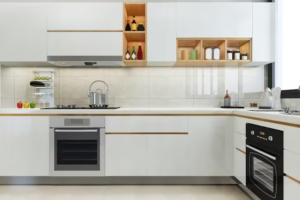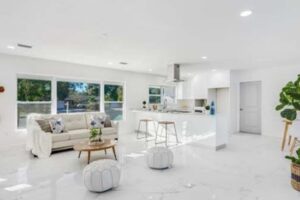Introduction
In a world where your surroundings influence mood, productivity, and well-being, interior design is no longer a luxury—it’s a necessity. Whether it’s your home, office, or commercial space, how it looks and feels plays a vital role in your daily life. But interior design goes far beyond aesthetics. It’s about creating functional, comfortable, and emotionally engaging environments that reflect your personality or brand.
What is Interior Design, Really?
Many people confuse interior design with decoration. While decorating focuses on surface aesthetics—paint colors, furniture, and accessories—interior design dives much deeper. It’s the science and art of enhancing interior spaces for optimal functionality, safety, and beauty. It blends architecture, psychology, and creativity to craft environments that serve both form and function.
Interior designers don’t just make a room look good—they analyze how people use the space and design it to improve that experience. They consider lighting, layout, ergonomics, color theory, spatial arrangements, and much more.
Why Interior Design Matters
Whether you’re redesigning a living room or outfitting a new office, hiring a professional interior designer can make a world of difference. Here’s why:
1. Maximizing Functionality
A beautifully designed room is pointless if it’s not practical. Interior designers evaluate how a space will be used and optimize it for that purpose. For example, in a kitchen, a designer will ensure there’s an efficient workflow between the stove, fridge, and sink—what’s known as the “kitchen work triangle.”
2. Enhancing Mood and Wellness
Colors, lighting, textures, and spatial arrangements can significantly affect our emotions. Interior designers use these elements strategically to create calming bedrooms, energizing workspaces, or cozy living areas. They know how to blend natural and artificial lighting to enhance a room’s ambiance.
3. Adding Value to Your Property
A well-designed interior can substantially boost a property’s value. Whether you’re selling a home or attracting clients to your business, thoughtful design makes a powerful impression. Potential buyers and customers often make snap judgments based on visual appeal, and a professionally designed space gives you the edge.
4. Saving Time and Money
Contrary to popular belief, hiring an interior designer can actually save money. Designers help you avoid costly mistakes, select the right materials, and plan within budget. Their industry connections can also get you access to exclusive deals and products.
Key Elements of Interior Design
A successful interior design project includes several core components. Let’s explore the foundational pillars of design that professionals use to transform ordinary spaces into stunning masterpieces.
1. Space Planning
The layout of furniture and décor needs to be intentional. Designers evaluate available space and decide how best to distribute it for movement, flow, and purpose. Whether working with a compact studio or a large open-plan office, spatial planning is crucial.
2. Color Theory
Color is one of the most powerful tools in interior design. It can evoke feelings, highlight features, or change the perception of a room’s size. Designers use complementary and contrasting color schemes to create harmony and energy within a space.
3. Lighting
Natural and artificial lighting can dramatically alter how a space looks and feels. Interior designers consider different types of lighting—ambient, task, and accent—to enhance functionality and highlight focal points.
4. Materials and Textures
Textures add depth and personality to a room. The contrast between soft fabrics, polished wood, and rugged stone can create a layered, dynamic environment. Choosing the right materials also impacts maintenance and longevity.
5. Furniture and Accessories
From modern minimalist to rustic charm, furniture anchors the design style. Designers select pieces not only for their looks but also for comfort, durability, and fit. Accessories like rugs, artwork, and cushions pull the space together.
Current Interior Design Trends in 2025
Just like fashion, interior design evolves with time. In 2025, several trends are reshaping how we style our living and working spaces.
-
Sustainable Design: Eco-friendly materials, upcycled furniture, and energy-efficient layouts are becoming staples.
-
Biophilic Design: Incorporating nature indoors through plants, natural light, and organic textures is in high demand.
-
Multifunctional Spaces: Especially in urban settings, rooms need to serve multiple purposes. Think home office by day, guest room by night.
-
Minimalism with Personality: Clean lines and neutral tones remain popular, but people are adding personal touches through bold artwork or unique textures.
-
Smart Technology Integration: From smart lighting systems to automated climate control, technology is blending seamlessly into interior design.
Residential vs. Commercial indoor design
indoor design isn’t one-size-fits-all. The approach changes depending on the type of space.
Residential Design
In homes, the focus is on personal comfort, aesthetics, and functionality. Interior Designer work closely with homeowners to reflect their lifestyle and tastes. From open-concept kitchens to spa-like bathrooms, residential design is deeply personalized.
Commercial Design
Businesses need environments that reflect their brand and optimize productivity. indoor designers help create retail stores that drive sales, offices that foster collaboration, or restaurants that offer memorable experiences. Safety, accessibility, and efficiency are top priorities.
Choosing the Right Interior Designer
If you’re considering hiring a professional, it’s essential to choose the right fit. Look for:
-
Portfolio and Experience: Review past projects that align with your vision.
-
Client Reviews: Positive testimonials speak volumes about reliability and quality.
-
Communication Style: A good designer listens to your needs and translates them into actionable design plans.
-
Budget Transparency: Choose someone who respects your budget and delivers maximum value.
Final Thoughts
Interior design isn’t just about pretty furniture or paint colors—it’s about creating spaces that work, inspire, and feel like home. Whether you’re starting from scratch or refreshing a room, investing in professional design can elevate your space in ways you never imagined.
In today’s fast-paced, visual-first world, a well-designed interior is a powerful tool. It enhances daily life, boosts mood, and even increases property value. So, if you’re ready to transform your space, start with thoughtful, purpose-driven indoor design. Because great design doesn’t just look good—it feels right.
See More Visit Website: Click here



